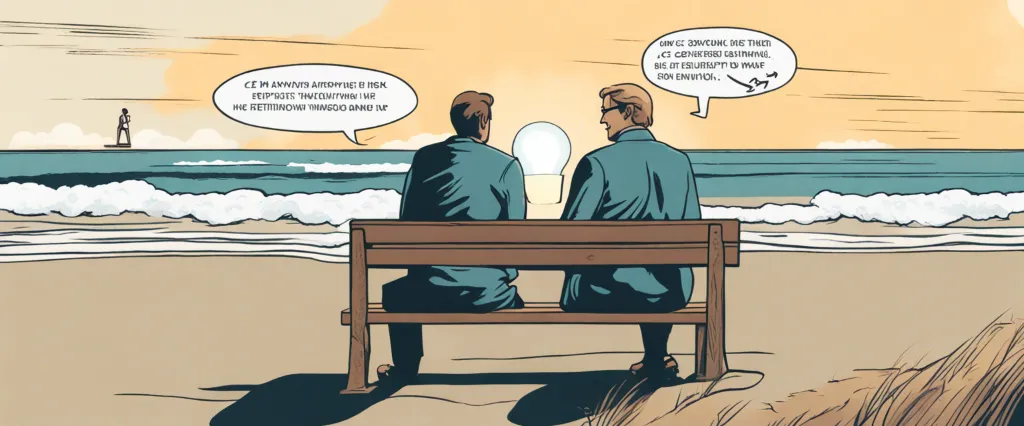In “The Saint, the Surfer, and the CEO,” author Robin S. Sharma weaves an inspiring tale that fuses the wisdom of three distinct characters into a remarkable journey of self-discovery and personal transformation. With his unique storytelling ability and insightful teachings, Sharma invites readers to embark on a spiritual odyssey that explores the depths of human nature and the pursuit of true happiness. Renowned for his expertise in personal development and leadership, Robin S. Sharma empowering individuals to tap into their inner potential and live a fulfilling life.
Chapter 1: The Saint – Discovering Inner Peace and Spiritual Wisdom
Chapter 1 of “The Saint, the Surfer, and the CEO” by Robin S. Sharma introduces the protagonist, Jack Valentine, a successful executive who finds himself at a crossroads in life. Despite material wealth and professional achievements, Jack feels a deep sense of emptiness and questions the purpose and meaning of his existence.
One evening, as Jack wanders through a charming coastal town, he stumbles upon a local bookstore. Intrigued by a book titled “The Story of Saint Francis” displayed in the front window, he decides to purchase it. Little does he know that this encounter will set him on a transformative journey towards inner peace and spiritual wisdom.
As Jack starts reading about Saint Francis of Assisi, he becomes captivated by the saint’s humility, simplicity, and compassionate nature. This presentation of a life dedicated to service and selflessness inspires Jack to reevaluate his own priorities, shifting from a relentless pursuit of success to a search for deeper fulfillment.
Through Saint Francis’ story, the chapter introduces the concept of the three archetypes: the Saint, the Surfer, and the CEO. The Saint represents a life centered on love, selflessness, and connection to something greater than oneself. The Surfer symbolizes the pursuit of personal happiness, freedom, and spontaneity. The CEO embodies material success, leadership, and external achievements.
Jack realizes that he has primarily embodied the CEO archetype, neglecting the Saint and Surfer within him. This realization sparks a desire for transformation and leads him to ask fundamental questions about living a more fulfilling life.
In conclusion, Chapter 1 lays the foundation by introducing Jack Valentine and his journey of self-discovery. It presents the contrast between his life as a successful CEO and the timeless wisdom of Saint Francis, leading him to question his own priorities and seek a path that combines the passion of the Surfer, purpose of the Saint, and achievements of the CEO.
Chapter 2: The Surfer – Embracing Change and Living in the Present Moment
Chapter 2 of “The Saint, the Surfer, and the CEO” by Robin S. Sharma is titled “The Surfer – Embracing Change and Living in the Present Moment.” In this chapter, the author introduces Jack Valentine, known as the Surfer—a wise and insightful character who helps the protagonist, Jack, on his journey towards personal enlightenment.
The Surfer embodies the idea of embracing change and living in the present moment. He demonstrates how being fully present and open to new experiences can lead to a deeper sense of fulfillment and purpose in life. Jack learns that the key to true happiness is not found in accumulating material possessions or chasing external achievements, but rather in choosing to live each moment fully.
The Surfer teaches Jack valuable lessons through his love for riding waves. He emphasizes the importance of surrendering to the flow of life, just as a surfer surrenders to the ocean’s movement. The Surfer encourages Jack to let go of his fears and judgments, allowing him to experience the beauty and freedom that comes with embracing change.
Throughout their conversations, the Surfer challenges Jack to question his perception of reality and the self-imposed limitations that hold him back. He helps Jack realize that worry, fear, and attachment to outcomes only serve to hinder his growth and prevent him from fully experiencing the present moment.
By the end of the chapter, Jack begins to understand the profound impact that embracing change and living in the present moment can have on his life. He recognizes the need to let go of past regrets and future worries, and instead focus on appreciating the beauty of each moment. Jack’s journey with the Surfer marks the beginning of his transformation from a man driven by external success to one in pursuit of inner peace and true fulfillment.
Chapter 3: The CEO – Achieving Success and Fulfillment in the Business World
Chapter 3 of “The Saint, the Surfer, and the CEO” by Robin S. Sharma focuses on achieving success and fulfillment in the business world through the perspective of the CEO character, Jack Valentine.
The chapter begins with Jack being admired for his professional achievements and his ability to manage a successful business empire. However, Jack is secretly unfulfilled and feels a sense of emptiness in his life. Despite his wealth and success, he realizes that material possessions and external achievements are not the key to true happiness.
In search of a deeper purpose, Jack embarks on a personal journey to discover what truly matters in life. He meets Father Time, a sage-like figure who imparts profound wisdom and teachings to guide Jack on his path.
Father Time emphasizes the importance of self-discipline, explaining that success is not found through shortcuts or instant gratification. He encourages Jack to focus on living a life of purpose and offers the notion that true success and fulfillment can only be achieved when one aligns their actions with their core values and dreams.
Through their discussions, Father Time helps Jack understand that success is not only about financial wealth or professional accomplishments. It is about finding inner peace, making a positive difference in the lives of others, and constantly growing and learning.
By the end of the chapter, Jack realizes that he needs to redefine his definition of success and make a shift in his priorities. He determines that true success lies in balance, personal development, and creating a positive impact on the world, rather than solely chasing external achievements.
Overall, Chapter 3 highlights the importance of combining success with fulfillment, and the need for individuals to align their actions and values to find true happiness and purpose in the business world.
Chapter 4: The Power of Relationships – Nurturing Meaningful Connections with Others

Chapter 4: The Power of Relationships – Nurturing Meaningful Connections with Others in the book “The Saint, the Surfer, and the CEO” by Robin S. Sharma explores the significance of relationships in our lives and the importance of nurturing them.
The chapter begins by emphasizing the impact of meaningful connections on our happiness and fulfillment. It highlights that while achievements and success are important, true fulfillment comes from the quality of our relationships. The author emphasizes that we must prioritize relationships and invest time and effort in strengthening them.
Sharma discusses the different types of relationships that exist, including our relationships with family, friends, coworkers, and even strangers. He emphasizes that each connection holds immense potential for growth, joy, and learning. The author argues that by nurturing these relationships and cultivating trust, empathy, and love, we can create a positive ripple effect in the lives of others and ourselves.
Furthermore, the chapter emphasizes the value of selflessness in relationships. Sharma suggests that by shifting our focus from “What’s in it for me?” to “How can I serve and add value to others’ lives?” we can build deeper, more meaningful connections. The author encourages readers to practice acts of kindness, compassion, and gratitude regularly as simple ways to nurture relationships.
Additionally, the chapter discusses the significance of forgiveness and letting go of grudges in order to maintain healthy relationships. Sharma stresses that forgiveness is not about forgetting or condoning hurtful actions; rather, it is about liberating ourselves from the burden of negative emotions and making space for growth and healing.
Overall, Chapter 4 underscores the transformative power of relationships and encourages readers to prioritize and invest in them. By nurturing meaningful connections, practicing selflessness, and cultivating forgiveness, we can experience deeper fulfillment and make a positive impact on the lives of others.
Chapter 5: The Four Breakthroughs – Unleashing Personal Potential and Growth
Chapter 5 of “The Saint, the Surfer, and the CEO” by Robin S. Sharma revolves around four breakthroughs that help individuals unleash their personal potential and foster growth in their lives.
The first breakthrough Sharma discusses is the discovery of one’s purpose. He emphasizes the importance of finding meaning and passion in our lives because it serves as a guiding force. By aligning our actions with our purpose, we can unlock our true potential and find fulfillment.
The second breakthrough revolves around the notion of vision. Sharma explains that having a clear vision of what we want to achieve enables us to set goals and make better choices. He encourages readers to visualize their ideal life and create a detailed blueprint to work towards it.
The third breakthrough Sharma introduces is the cultivation of self-belief. He highlights the significance of believing in oneself, as this confidence propels us to overcome challenges and take risks. By eliminating doubts and fears, we unlock the power within us to accomplish great things.
The final breakthrough explores the importance of constant learning and growth. Sharma advocates for a lifelong commitment to personal development through reading, seeking mentors, and attending seminars. By continuously expanding our knowledge and skills, we evolve as individuals and maximize our potential.
Overall, this chapter emphasizes the significance of purpose, vision, self-belief, and continuous growth in unleashing personal potential. Sharma believes that by embracing these four breakthroughs, individuals can create lives of purpose, joy, and success.
Chapter 6: The Joy of Simplicity – Finding Happiness in a Complex World
Chapter 6: The Joy of Simplicity – Finding Happiness in a Complex World of Robin S. Sharma’s book “The Saint, the Surfer, and the CEO” delves into the importance of simplicity in order to find true happiness in a world that is often overwhelmed by complexity and materialism.
The chapter begins by emphasizing that the key to finding happiness lies in simplifying our lives. Sharma stresses that simplicity is not about living with less or denying ourselves pleasure, but rather about focusing on what truly matters and finding joy in the present moment. He states that simplicity allows us to clear our minds and cultivate a deeper sense of peace, gratitude, and fulfillment.
Sharma offers practical tips for incorporating simplicity into our daily lives. He encourages readers to declutter their physical environment, suggesting that by simplifying our surroundings, we can create a harmonious space that enhances our well-being. Additionally, he advises embracing simplicity in our relationships, by letting go of toxic connections and nurturing meaningful connections with others.
The author also explores the concept of minimalism, advocating for a more conscious and intentional approach to consumption. He encourages readers to evaluate their needs versus wants, and to focus on experiences rather than material possessions. By doing so, Sharma argues, we can reduce our dependence on external factors for happiness and find contentment within ourselves.
Sharma concludes the chapter by emphasizing the transformative power of simplicity, stating that by embracing simplicity in all aspects of our lives, we can unlock a greater sense of fulfillment, freedom, and joy. He advises readers to take small steps towards simplicity, recognizing that it is a lifelong journey, but one that ultimately leads to a more meaningful and purposeful existence.
Chapter 7: The Wisdom of Self-Management – Taking Control of Your Life and Priorities
Chapter 7: The Wisdom of Self-Management – Taking Control of Your Life and Priorities, of the book The Saint, the Surfer, and the CEO by Robin S. Sharma, focuses on the importance of self-management and taking control of our lives to lead a more purposeful and fulfilling existence.
The chapter begins by emphasizing that our ability to manage ourselves is a key determinant of our success and happiness. The author emphasizes that true success is not just about achieving external goals, but also about developing and practicing the inner qualities of character and self-discipline.
Sharma introduces the concept of “Time Investment,” which suggests that we should treat our time like a valuable resource, just as we do with money. He encourages readers to analyze how they are investing their time and make conscious choices to prioritize activities that align with their values, goals, and purpose. By understanding the value of time and managing it wisely, we can become more productive and create a life that is more meaningful and fulfilling.
The chapter also explores the idea of “unique self-expression,” highlighting the importance of discovering and embracing our individual talents and passions. Sharma suggests that by pursuing activities that align with our natural abilities and interests, we can tap into our true potential and experience a deeper sense of fulfillment and happiness.
Furthermore, the author stresses the significance of setting clear priorities and focusing on the most important tasks. He encourages readers to identify their top priorities and take consistent action towards those goals. By eliminating distractions and staying focused, we can accomplish more and lead a more purpose-driven life.
In summary, Chapter 7 emphasizes the importance of self-management, time investment, unique self-expression, and setting clear priorities. By practicing these principles, we can take control of our lives, achieve personal growth, and live a more fulfilling existence.

Chapter 8: The Path to Greatness – Embracing Your True Purpose and Making a Difference
Chapter 8 of “The Saint, the Surfer, and the CEO” by Robin S. Sharma is titled “The Path to Greatness – Embracing Your True Purpose and Making a Difference.” In this chapter, Jack, the CEO, continues his transformative journey with the guidance of the Saint and the Surfer.
The chapter starts with the Saint asking Jack to reflect on his legacy and whether he has truly embraced his true purpose in life. Jack realizes that he has been pursuing success and power without considering the impact he can make on others and the world around him. With this realization, the Saint encourages Jack to redirect his focus towards making a difference and becoming great.
The Surfer advises Jack to embark on a journey of self-discovery and to embrace his unique gifts and talents. He encourages Jack to find his passion and align it with his purpose. The Surfer emphasizes the importance of living a life true to oneself rather than seeking validation through external accomplishments.
Throughout the chapter, the Saint, the Surfer, and Jack engage in discussions about the power of love, forgiveness, and the significance of leaving a positive and lasting legacy. Together, they explore the idea that greatness is achieved not by achieving personal success alone but by using one’s talents and resources to make a positive impact on others.
By the end of the chapter, Jack commits himself to a life of service, vowing to use his position as a CEO to create positive change and to inspire others to do the same. He understands that greatness lies in making a difference and embracing his true purpose.
In summary, Chapter 8 focuses on the importance of embracing one’s true purpose and making a difference in the world. It highlights the significance of living a life aligned with one’s passion and using one’s talents and resources to positively impact others. The chapter inspires readers to reflect on their own journey and consider how they can leave a lasting legacy by choosing a path that aligns with their true purpose.
After Reading
In conclusion, “The Saint, the Surfer, and the CEO” by Robin S. Sharma is a thought-provoking book that offers valuable insights on finding true happiness, balance, and purpose in life. Through the wisdom of three diverse characters, the book explores important topics such as self-discovery, mindfulness, compassion, and the pursuit of personal and professional success. Sharma’s storytelling approach effectively engages readers and showcases the transformational journeys of the Saint, the Surfer, and the CEO. Ultimately, the book encourages individuals to embrace their inner wisdom, prioritize meaningful relationships, and live with intention, reminding us all of the profound power within ourselves to create a fulfilling and purpose-driven life.
1. The Alchemist” by Paulo Coelho: Similar to “The Saint, the Surfer, and the CEO,” this novel explores themes of personal development, self-discovery, and finding one’s true purpose in life. With its inspiring narrative and spiritual undertones, “The Alchemist” encourages readers to pursue their dreams and listen to their hearts.
2. The Four Agreements: A Practical Guide to Personal Freedom” by Don Miguel Ruiz: This book offers insightful and practical wisdom that can transform lives. Like “The Saint, the Surfer, and the CEO,” it delves into the importance of self-awareness, mindfulness, and personal growth, providing readers with practical tools to create a more fulfilling and purpose-driven existence.
3. The Power of Now: A Guide to Spiritual Enlightenment” by Eckhart Tolle: Much like Robin S. Sharma’s book, this transformative work explores the power of living in the present moment. Through deep reflections on spirituality, consciousness, and self-realization, Tolle guides readers on a journey toward inner peace and a more conscious way of living.
4. Man’s Search for Meaning” by Viktor E. Frankl: This classic memoir delves into the power of finding meaning in the midst of suffering. Like “The Saint, the Surfer, and the CEO,” it examines the importance of aligning one’s actions with their values and cultivating a sense of purpose, ultimately demonstrating that even in the face of adversity, individuals can find meaning and create a fulfilling life.
5. “The Power of Positive Thinking” by Norman Vincent Peale: This influential book explores the profound impact positive thoughts can have on a person’s life. Similar to Robin S. Sharma’s work, Peale encourages readers to embrace optimism, cultivate a positive mindset, and develop resilience to overcome life’s challenges. By highlighting the power of positive affirmations, he offers practical techniques to improve one’s wellbeing and achieve personal success.




